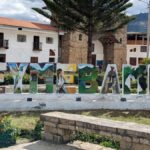First published on September 21, 2022 • Last updated on July 12, 2023
This page may contain affiliate links; if you purchase through them,
we may receive a small commission at no extra cost to you.
Looking for the perfect bird identification book for your next trip to Ecuador?
Depending on your level of interest, I recommend different birds guides for you to consider.
Most of these books are available for purchase in the United States. However, if you would prefer to purchase while in Ecuador, I recommend contacting Fernanda Salazar, who can deliver books to your hotel or home in Quito. She sometimes sends books that are hard to come in the United States by DHL. This website make no money from Fernanda’s sales.
Most Comprehensive Bird Identification Guide
The most comprehensive guide for identifying birds is The Birds of Ecuador by Robert Ridgely and Paul J. Greenfield. The copy that I own is the Spanish language version that comes in two separate volumes.
In the English version, this book is more often sold with both volumes bound together, making it even more unwieldy. Reviewers have spoken of taking the book apart and having it rebound with a spiral spine. In my view, that’s an expensive undertaking for an already expensive book. You may want to ask the vendor which version is available before ordering.
If you can manage to purchase the two volumes separately, you get the best of both worlds – a slim book of color plates for identification in the filed in Volume 1 and a ton of information about each bird in Volume 2.
Volume 1 (Status, Distribution, and Taxonomy) is an encyclopedic collection of every bird in Ecuador that includes a map with geographic distribution, a detailed physical description, a list of similar species, habits that will help you know where to find this bird, and the sound of its voice. It’s a heavy tome in black and white. In my opinion, it is best used as a desk reference or for breaking out at the eco-lodge to confirm sightings earlier that day. In fact, most birdwatching establishments will have a copy on hand, though sometimes it will be the Spanish language version.
Volume 2 (Field Guide) is a thin, more manageable book than its partner and will readily fit in a backpack, serving as an adequate field guide. It is comprised of 96 full-color plates and short descriptions of each bird and their similar species. I love my Spanish language version as it lists bird names in Spanish, English, and Latin. The downside of this book as a field guide is that it does not include maps though it does mention habitats.
I recommend this set for dedicated birdwatchers who would like a comprehensive bird guide when working at home. Furthermore, if you would like to improve your Spanish, consider picking up this guide in Ecuador where the Spanish language version is available (and includes English names of the birds).
The Birds of Ecuador: Field Guide Volumes 1 & 2
by Robert S. Ridgely & Paul J. Greenfield
Your purchase helps support our website.
Best Fieldbook for Birdwatchers
If you are looking for a field book alone, you could do far worse than purchase a copy of Fieldbook of the Birds of Ecuador by Miles McMullan & Lelis Navarrete. This slim but comprehensive guide is easy to read.

With 6 to 8 species listed per page, this book manages to pack a lot of information into a tight format. Each description includes a color, artistic rendering of the male and female of each species, names in English and Latin but not Spanish, a short description of its geographic range, how easy it is to see, and a map marked with its location and seasonality.
Bonus pages at the end of the book include short descriptions and pictures of Ecuador’s most iconic mammals. It’s a fair addition but unlikely to be of much help in the field.
Unfortunately, this book is not always available through Amazon but can be purchased in Ecuador.
Fieldbook of the Birds of Ecuador
by Miles McMullan & Nellis Navarrete
Your purchase helps support our website.
Most Popular Ecuadorian Bird Guide
With over 81 reviews and 4.7 stars on Amazon, the Birds of Ecuador (Helm Field Guide) by Robin Restall and Juan Freile, is the most popular Ecuadorian bird guide available.
Published in 2018, this is also the most up-to-date bird guides as of the date of this publication. Information about the bird, including size, location, habitat, full description including voice, and a map showing its range are accompanied on the facing page by artistic renditions of the bird, including variants when appropriate. Having this information side-by-side near similar species makes it easy to rapidly hone in on the target species.
As an intermediate birdwatcher, I really appreciate the plate that includes images of three different birds with a description of every body part, including terms like median wing-coverts, surpercilium, and retrices. While I don’t use those terms everyday, I find that learning how to look for specific markings can seriously help identify hard to distinguish species in the field.
Some people remarked that the bird guide is a little too large to make it easily portable. However, others felt its size was necessary to cover the wide variety of birds found on continental Ecuador. Most were happy that the it was extensive without being overly large.
I have yet to use this guide personally but look forward to purchasing a copy before my next trip to Ecuador!
Birds of Ecuador (Helm Field Guides)
by Robin Restall and Juan Freile
Your purchase helps support our website.
Best Bird Guide for Hummingbird Lovers
If you are out to see as many of Ecuador’s hummingbirds as possible, you would do far worse that buy a copy of Robert Ridgely’s Hummingbirds of Ecuador.

Ridgley provides information on 120 of Ecuador’s most common seen hummingbirds. Each bird is treated to two full pages of information broken into sections: recognition, distribution, behavior, and feeders. This latter is especially helpful as it includes the name of some lodges and reserves where the birds in known to visit feeders. Some birds include a note on taxonomy.
Better yet, most species have 3-4 photos of both male and female hummingbirds. Seeing the birds from different angles and in different light can add essential information when trying to make a tough identification.
The downside to this book is that it was published in 2011 and does not include newly discovered species like the Blue-throated Hillstar. Nor does it include newer locations with feeders where hummingbird viewing is becoming very popular. However, it is still the best Ecuadorian hummingbird guide out there.
Best Bird Guide For Kids and Kids at Heart
If you are looking for a gift for a kid headed on their first trip to Ecuador, the book Wildlife of Ecuador by Andrés Vásquez Noboa would be a great addition for their backpack. It is full of colorful photos, taken by wildlife photographer Pablo Cervantes Daza.
Naturalists will like this book because it includes many different kinds of critters that are possible to see on most trips to Ecuador, including amphibians, reptiles, birds, and mammals
While this book is not a bird guide alone, it includes the most common species of birds that visitors to the coast, the Sierra, and the Amazon will most likely encounter. That’s why I wanted to include it in this collection of bird guide reviews.
I rarely use this book for bird identification but love to pull it out when trying to identify other animals I may have seen on a trip. After all, most birdwatchers are naturalists at heart and appreciate knowing the other creatures they may have seen on a trip. It helped me identify an Andean White-eared Opossum I saw while staying near Milpe.
Other Bird Guides
While writing this article, I found some other books you might be interested in. We will continue to add new books to our online store at Bookshop.org.
If you have a bird guide that you prefer and would like to recommend it to our readers, let us know in the comments below!


























